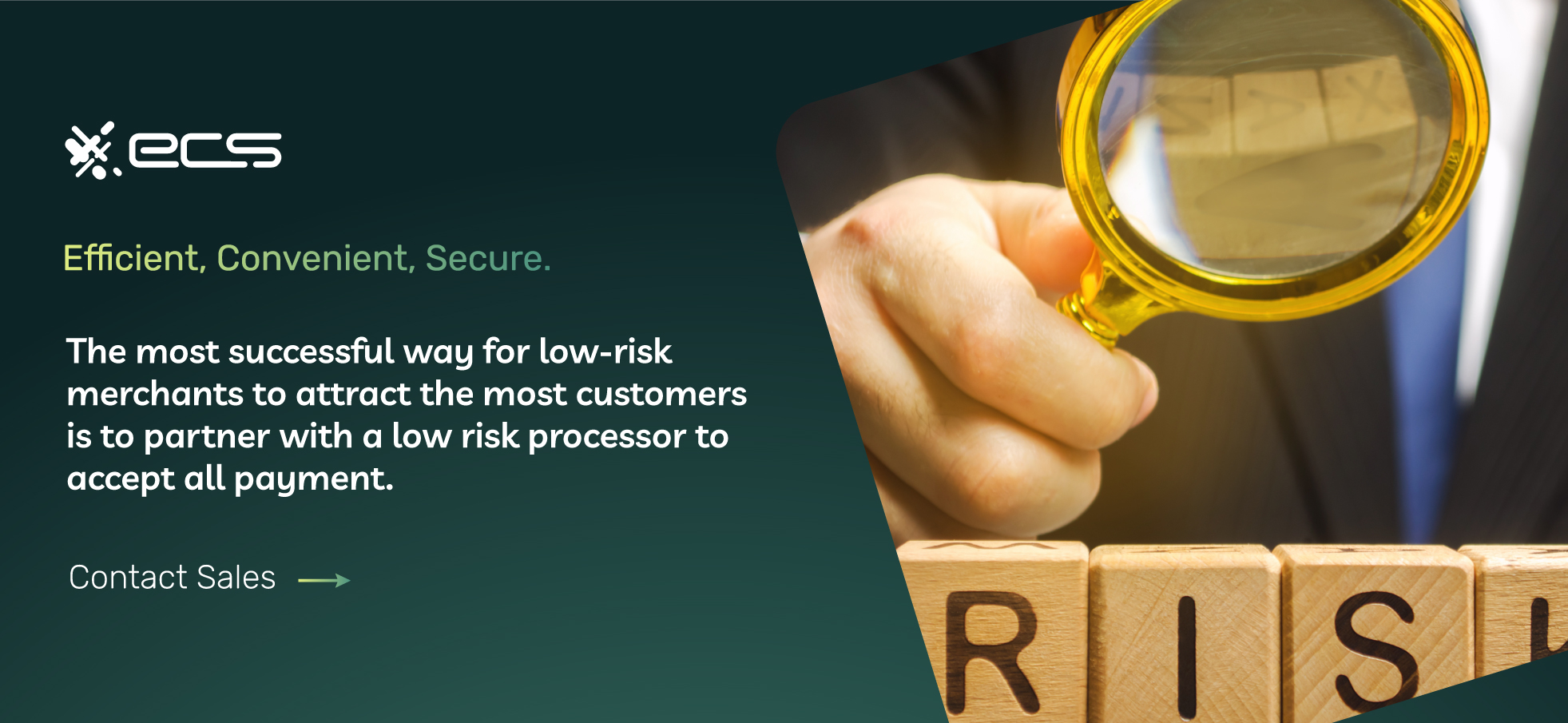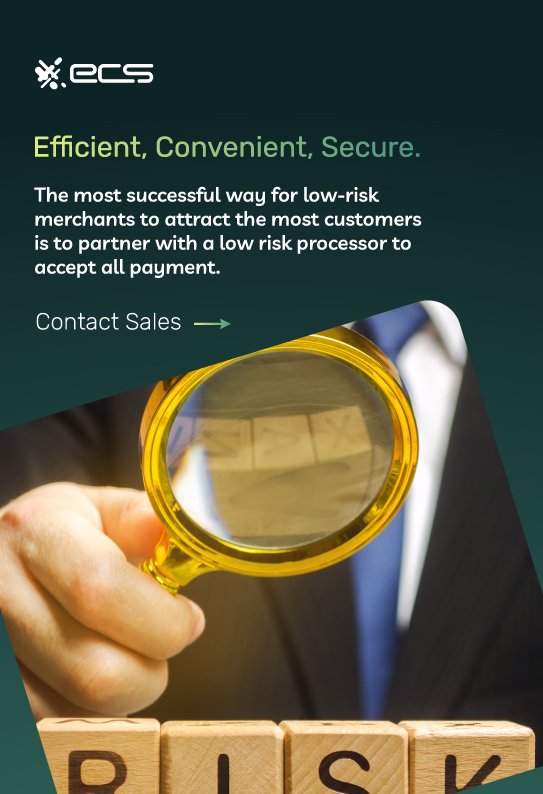Getting paid is important. To get paid, in any business, you will need to, of course, accept payment. But, the most successful way to attract the most customers is with payment flexibility, which means to accept all types of payment methods including credit and debit cards. To accept and be paid for credit card transactions, you must find a credit card processor and obtain a merchant account.
To do this, you will need a low-risk merchant processor to facilitate all your digital transactions. That is unless, of course, you aren’t low-risk. But how do you know?
In this article, we explore merchant accounts and payment processors for low and high-risk merchants. We also go over how to tell the difference and determine where your business lies in the grand scheme. From there, you should know how to research and find the best payment processor for your needs.
What Are Merchant Accounts?
Merchant accounts are simply another name for credit card processing accounts. Merchants can process credit cards in 2 ways: In person, with a point-of-sale (POS) device or physical terminal, or as a card-not-present transaction, online or over the phone. These payments are submitted to the credit card processing company through the payment gateway via a physical or virtual terminal.
When applying for payment processing services, your type of merchant account will be distinguished as either low-risk or high-risk. Payment processors determine your risk level based on key pieces of information about your business such as age, industry, credit score, reputation, and so forth. The processor will also provide your rates and account options based on the assigned risk level.
Redeeming a merchant account can only be done through a merchant service provider. Based on your merchant account ranking, your processing provider could be an independent office that has relationships with multiple banks or it could be a singular bank or processor.
Depending on a bank’s comfort level, they can decide which type of merchants they will work with, and which ones they won’t. These decisions are on a case-by-case basis, and can constantly change.
Who Are High-Risk Merchants?
A bank’s decision on risk level is a case-by-case basis and can change. Which means that one bank may consider a merchant a high-risk business, while another may not. Although this can seem like a tricky and non-definitive process, there are a few key factors that typically play a huge role in determining whether or not a merchant needs to apply for a high-risk credit card processing account.
A merchant account may be classified as high-risk due to one or more of the following factors:
- If there are any specific government regulations on the products and services
- If there are any specific age restrictions on their products and services
- If the business itself or the general industry has a high chargeback rate
- If there is a history of substantial fraudulent transactions
- If the business is new
- If the business lacks financial stability
- If the business lacks a quality reputation
- If the business owner has poor credit
- If the business accepts multiple currencies
- If the average credit card transaction is over $500
- If the average monthly transaction volume is over $20,000
- If the business sells to countries associated with high levels of fraud
- If recurring plans or subscription payments are offered
- If a merchant is on the MATCH list
High-Risk Industries
If you are unsure if your business would have any of these risk factors, you may have a better idea of your risk status if your business lies in one of the following industries:
- Adult entertainment and products
- Brokerage firms
- Cannabis
- CBD
- Vape products
- Tobacco
- Cryptocurrency
- Dating services
- Debt collections
- High-dollar electronics
- Gambling
- Gun dealers
- Life coaches
- Medical practices
- Multi-level and network marketing
- Nutraceuticals
- Pharmaceuticals
- Telemarketing
- Timeshares
A vast majority of payment processors and banks will typically deny a high-risk merchant because the account has the potential to cost the bank an unnecessary loss of funds. However, it is possible to find processors that focus mainly on high-risk. However, if a high-risk merchant processor approves a high-risk merchant, they may charge a higher interchange rate or processing fees.
You may be wondering how to become a merchant processor’s low-risk client if your business falls in line with some of the high-risk key factors. Do not worry, high-risk does not necessarily have a negative impact or connotation. In fact, many high-risk industry products can be easily marked up with higher ticket prices to compensate for high-risk merchant account fees.


What is a High-Risk Merchant Processor?
High-risk processors maintain relationships with acquiring banks that allow processing for high-risk industries. A high-risk merchant card processor would have the capability to approve and offer its processing services to high-risk merchants. Some high-risk processors may accept some risky businesses and not others. Based on how a bank feels, the decision will be a case-by-case scenario.
Even if a high-risk processor approved yours merchant account, merchant services for high-risk industries may come with some stipulations or limitations. Your merchant account may be subject to rolling reserves, higher interchange fees, longer contracts, and pricey early termination fees. Additionally, you may have certain limits or roadblocks when it comes to processing online or over-the-phone card-not-present transactions.
If this is the case, you will need to look for a merchant service provider that offers high risk virtual terminals. Ultimately, if you are definitely in need of processing high-risk transactions online and you are unsure whether or not a processor offers these services, you can always call their customer support number to verify before taking the time to apply for their merchant services and payment processing solutions.
Who are Low-Risk Merchants?
Now that we have an understanding of who high-risk merchants are and the type of credit card processors they must use, we can dive a little deeper into the world of low-risk merchants and low-risk merchant processors.
A merchant account may be classified as low-risk due to one or more of the following factors:
- If the average monthly transaction volume is less than $20,000
- If the average ticket is less than $500
- If the business accepts only one type of currency
- If the business has low to zero chargebacks
- If the business is in a low-risk industry and sells low-risk items or services
- If the business has a positive reputation
- If the business maintains consistent revenue and normal business days and operating hours
Low-risk merchants pertain to the vast majority of the following market industries:
- Automotive
- Convenience stores
- Construction
- Education
- Food and beverage services
- Healthcare
- Hospitality
- Household and office supplies
- Personal care and beauty supplies and services
- Retail
- Pet supplies
- Small businesses
- Most professional services
In all honesty, low risk merchants are the most common type of businesses. They require traditional payment processors and usually have a very easy time acquiring a merchant account for credit card payment processing.
What is a Low-risk Merchant Processor?
Merchant accounts are ultimately low-risk if the bank and payment processor are confident that the business has a good reputation with consistent profit. This will ensure the processor that their investment is secure. The business must also reflect evidence that it will not be generating a high rate of chargebacks, fraud, or complaints. Low-risk businesses show a small likelihood of racking up unpaid fees and costing the banks and processors money.
Most low-risk merchant services credit card processors only focus on national processing. Business done outside of national borders can cause risk. This is why low-risk merchants must only deal in one form of currency.
However, low-risk merchant processors can also process high-risk merchants. Some credit card processors do business with both types of merchants. Because of this, the processor will need to have outstanding relationships with a variety of banks that offer a multitude of payment services for the diversity in their business markets.
Types of Transactions Low-Risk Merchants Can Process
As a low-risk merchant, you do not face the same limitations as high-risk merchants as to what type of payment solutions you can offer your clients for payment. It is up to you to determine which solutions make the most sense with your business structure and which are the most cost-effective.
Low-risk merchants can accept digital payments via credit cards, debit cards, and ACH. Credit card transactions are subject to the credit network through Visa, Mastercard, American Express, and Discover.
Debit card transactions go through the debit networks. These include Star, Pulse, Interlink, and more.
ACH payments are digital payments that use bank account and routing numbers and are facilitated by the ACH (Automated Clearing House) network.
If you want to cater to most consumers, you will want to try to offer all three options. But especially credit cards, as these are the most common form of payment consumers carry. ACH transactions, on the other hand, may be far less common. They are mostly useful for money transfers and recurring bill payments such as rent and utilities.
ACH Benefits Compared to Card Payments
The plus side of the ACH network? It requires no equipment (other than internet access and a virtual terminal), and the fees are less costly than credit card fees: A few cents regardless of the transaction, compared to a percentage of the total sale for credit cards.
But if you’re looking to save costs and still offer digital payment options and ACH isn’t a good option for your type of business, the debit card network is the less costly option between the two (credit and debit).
Ultimately, however, if you want to attract the most customers and offer the most convenience, credit card solutions will benefit you most. Yes, they may be a little more pricey, but in the end, that cost may be well worth it to appease more clients.

How Can Low-Risk Merchants Accept Digital Payments?
Merchants can accept credit, debit, and ACH transactions in various ways. First, ACH transactions, as mentioned, are only available via an online virtual terminal. Virtual terminals can also process online credit and debit card transactions.
Cardholders can provide payment information over the phone or via an online gateway. You can request payment information via QR codes and text-to-pay links, or a client can do this on their own if they shop online via eCommerce stores.
On the other hand, low-risk merchants can process credit and debit card transactions in person with a physical terminal or point-of-sale system. These devices can be countertop, wireless, or mobile for on-the-go merchants.
Can You Become a Low-Risk Business After Being Categorized as High-Risk?
In some cases, yes, there are a few things you can look into changing after your merchant account has been deemed high-risk. However, some factors cannot be avoided or changed. And therefore, it may be unlikely your business will ever be able to change its risk status.
Factors That Cannot Change to Adjust
Certain merchants are deemed high-risk based on their industry. If you are in the business of adult entertainment, CBD, gambling, or subscription services, there’s no way around your risk status. Based on what you sell and the dollar amount you are profiting off these transactions, you are and will always be a high-risk merchant for processors.
This, however, should not be discouraging. Many merchant service providers offer high-risk processing for these types of merchants.
Factors to Adjust to Aim for a Low-Risk Merchant Account
With that being said, if you are not stuck in certain unchangeable factors, focus on what you can change.
Currency
If your business accepts multiple currencies, look into only accepting currency only for the country you do business in. If you are an MSB, this may not be an option for you.
Business age
If your business is new, giving yourself some time to get off the ground, gain a steady profit, and establish itself in the market palace will provide more cushion for re-establishing yourself as a low-risk merchant.
Credit Score
If you have a low credit score, working toward increasing your credit score over time will better increase your chances of being viewed as less risky. Check with a financial advisor on how you can better your credit history.
Reputation
If your business has obtained a negative reputation over the years, it’s time to do some work to better your view in the public eye. Ways to combat negative reputations are to counter negative reviews with legitimate positive reviews online.
This is done through better and more memorable service, asking for reviews, and gaining client trust. Additionally, you can look into hiring a public relations specialist, serving the community, or being more upfront and transparent about the products and services offered and the cost that it entails.
Countries of Trade
If your business sells to countries associated with high levels of fraud such as Eastern Europe, Latin America, and African countries, consider changing your client base to more reputable markets such as the US, Canada, and the EU.
Subscriptions
If you offer recurring subscription payments, you run the risk of being considered high-risk. If it is only an option and not the main point of revenue for your business, consider only offering single-sale items.
Chargebacks
If you have a high chargeback ratio, consider implementing steps to combat this pesky problem. Offering clear terms and conditions, refund policies, and product and service details may help reduce chargebacks. Additionally, adding chargeback tools, secure websites, and a customer database may help you properly dispute and win any additional cases that come against you.

What To Do Next?
If you are looking into getting your business running and ready to accept all payment types, reach out to a credit card merchant processor through their customer service or sales departments to get more information on where your business lies, and if they can be of service to you.
Ultimately, whether your merchant account is labeled low-risk or high-risk, one is not definitively superior to the other. Each type of merchant account has its benefits and its obstacles. So long as a business properly serves its customers with appropriate pricing, products, and payment solutions, it will have a positive future ahead.
To contact sales, click HERE. And to learn more about ECS Low Risk Merchant Processing visit Credit & Debit.
Updated January 2024
